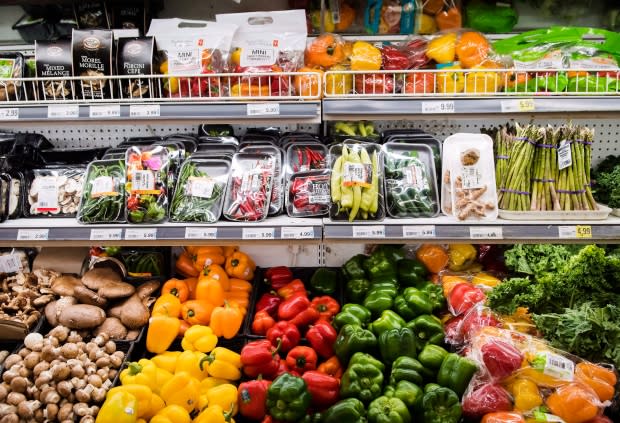New food guide unveiled without food groups or recommended servings

Instead of eating food from four groups, Canadians are now encouraged to follow three guidelines on: what to eat regularly, what to avoid, and the importance of cooking and preparing meals at home.
Health Minister Ginette Petitpas Taylor unveiled Canada's new food guide on Tuesday at a market in Montreal. It was last revised in 2007.
Our decisions on what to eat and how are influenced by a host of factors from taste to tradition, Petitpas Taylor said.
"Canadians deserve an easy simple source of advice they know they can trust," she said.
There's no longer an emphasis on food groups and recommended servings. Instead, Health Canada recommends eating "plenty of vegetables and fruits, whole grain foods and protein foods. Choose protein foods that come from plants more often." For instance, fruits and vegetables make up half the plate on the report's front cover and nuts, beans and seeds are more prominent.
"It's not about portion per se, but perhaps about proportion," Dr. Hasan Hutchinson, director general of Health Canada's Office of Nutrition Policy and Promotion, Health Products and Food Branch, told reporters.
The proportion approach can be incorporated into family meals and snacks, he said.
Health Canada said the guide is taught in schools and promoted by health professionals to support the goal of getting Canadians to eat well. It can also influence the foods served and sold at daycares and schools, recreation centres, workplaces and health-care facilities.
A two-page snapshot of the new 62-page guide for health professionals and policymakers includes a glass of water as the recommended "drink of choice."
The second of three guidelines covers foods and beverages that undermine healthy eating.

Consuming foods or beverages with added sugars has been linked to an increased risk of weight gain, excess weight and Type 2 diabetes, according to the guide.
The guide's authors also note there are health risks associated with alcohol consumption.
The guide was prepared using high-quality scientific reports on food and health, excluding industry-commissioned reports given the potential for conflicts of interest, according to Health Canada.
Hutchinson said that when officials scanned the evidence, they were struck by aspects of the food guides in Brazil, Sweden and Belgium. Fresh, unprocessed food is the cornerstone of the Brazilian food guide.
Cook more
The third guideline in Canada's revamped guide focuses on food skills such reminding people to be mindful of your eating habits and to eat meals together.
"It doesn't need to be complicated folks," Petitpas Taylor said. "It just needs to be nutritious, and, might I dare say, fun."
For parents, the most important takeaway is that juice and sugar-sweetened milk are beverages that should be limited and considered treats for themselves and for their kids, said Dr. Yoni Freedhoff, medical director of the non-surgical Bariatric Medical Institute in Ottawa.
"Overall though, the most important message is cook more, use less boxes, go to restaurants less frequently, not never but less, and remember that food marketers' job is to sell food. It's not to protect your health, and consider that too as there are inevitable criticisms launched by the food industry about this non-industry friendly food guide."
The full guide says food skills should be considered within the social, cultural and historical context of Indigenous people.
"It's quite different from the previous one because it talks about the context of eating," said Jean-Claude Moubarac, a professor in the nutrition department at the University of Montreal who advised on Brazil's food guide. "It goes way beyond just nutrients and food and really adopts this much more holistic approach, which is much more appropriate."
Food loaded with sugar, salt and fat
Moubarac is pleased with most of the new Canada's Food Guide. He said it makes it clearer to consumers to seek out fresh and minimally processed foods, and avoid highly processed foods. The food industry has three years to introduce new nutrition labels to food products detailing information such as processed sugar content.
He said one limitation is those new food labels will only be available in 2022.
Availability and accessibility concerns such as finances are another consideration in the guide.
The Toronto Foundation for Student Success aims to help students succeed in school by providing services such as meals after school. The group's executive director, Catherine Parsonage, said that while the new Food Guide offers a perfect menu, she worries about whether they'll be able to make it.
"Fresh fruits and vegetables, nuts, whole grain products are just out of the reach financially," she said.
The new guide includes a mobile-friendly version that will be continually updated with resources, such as recipes.
Health Canada is also working on healthy eating patterns for health professionals and policymakers with details on the amounts and types of foods to serve at institutions for people in different age groups and life stages.
Health Minister Ginette Petitpas Taylor unveils the revamped food guide:

